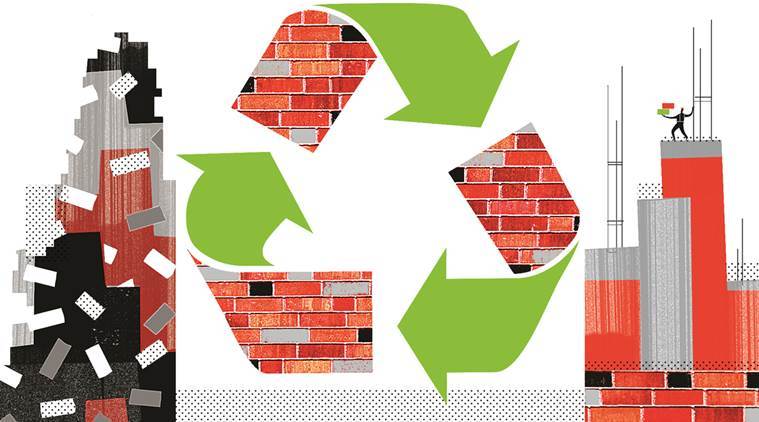In a world facing extreme environmental degradation, sound actions are necessary to improve our natural resources usage. We focus a lot on identifying the correct steps and implementing them, but do we invest as much thought in making sure we have followed through?
Being accountable to our decisions is an underrated step that, if done correctly, can determine the effectiveness of our “efficient” actions. Creating accountability can itself be your motivation to be environment-friendly. Or it can tell you if your supposedly efficient actions are not working; its time for a change. In this post, we will take a look at some ways in which you can become environmentally accountable individually, support an organization in becoming resource-efficient and help a country develop environmental and social accountability.
As an individual: Take an ecological footprint test!
Have you wondered what the impact of your activities on the environment is? The ways in which we impact the world around is complex, but there are now simple calculators available online that can tell you your impact by putting in information about your daily activities. It can be as detailed as you want; customized to the region you are living in. The ICICI Bank led initiative on World Environment Day is a simple calculator developed for India. If you live in the Netherlands, Zaailingen seems to be a very comprehensive footprint calculator (check out Romee Hoeksma’s post on how she used this calculator). The Ecological Footprint Calculator is a generic footprint calculator irrespective of your location. I took their quiz and the result was….


Making this test an annual event would be a great way to continuously test how you are improving your ecological footprint. My target next year would be to at least shift my Overshoot Day to July.
As an organization: Checks-and-balances through internal targets and competitions
It is becoming increasingly important for organizations to show their environmental accountability in today’s world. Sustainable procuring, production, manufacturing, distribution and consumption is being demanded by the market, the investors and bankers as well governments.
Consider the construction industry. It is the largest consumer of raw materials in the world. Built environments account for up to 30% of global carbon emissions. With growing urban environments, the construction industry is expected to grow, creating the need for sustainable construction that is resource efficient and decarbonized.
Many construction companies have adopted internal carbon pricing tools to measure, manage and mitigate their carbon footprint. In order to promote low-carbon practices and technologies, these companies add carbon as a cost for their units. If you are a running a unit under a construction company that has an additional budget line, it makes your operations expensive and you are likely to face internal competition. This provides a financial incentive within the company to switch to low-carbon practices. Some companies have collected these “internal taxes” into a pool that can fund R&D in low-carbon technologies (IFC & CPLC 2018IFC & CPLC 2018).
A construction company can augment their resource utilization by considering alternate sources of raw materials. Using construction and demolition (C&D) material blends, or fly-ash bricks are innovative ways to promote resource efficiency and become cost-effective. Most of the C&D goes to landfills anyway; why not buy them cheap and use them to offset virgin raw material procurement costs? Using efficient and low-carbon material in construction processes can be mandated within a company’s policy, by starting with a 20% lower limit of using recycled aggregates in construction. Construction companies can, in fact, build using specific materials that are suited for reuse as aggregates, increasing their long term profitability.

How can you apply this idea to your organization? Maybe you work at a software company. I am sure you use a lot of electronic devices. Could you come up with a system to provide a single window outlet to dispose all electronic goods so that it can be responsibly recycled?
As a country: No more GDP measurements
I admit that this is not a step you can take through direct initiatives, but it is always good to understand what can be improved in the national context. Gross Domestic Product (GDP) has been a measure of economic growth since the mid-1930s. GDP is a measure of the value of all goods and services produced. The more a country can produce that has a monetary value, the greater is the country’s GDP.
But what about things that cannot be valued? There is no uniform monetary value for time, clean air, or access to water in today’s world. GDP also neither considers the equitable distribution of the goods and services produced, nor the convenience with which these goods and services are accessed. Also, not all goods and services produced are for a good cause; would you consider more hospital trips to be a good thing for a country? In the two photos below, where would you rather live?
In recent years, the need for an alternative to GDP has risen. GDP is not a measure of well-being, merely income. So a more appropriate measure of a country’s growth would be to measure well-being: How many hours do you work? How many hours do you sleep? Do you live in a polluted city? How long is water supplied to your home in a day? Can you access internet services at all times?
One of the popular alternatives to GDP has been the Genuine Progress Indicator (GPI), which accounts for exactly the same questions I asked above. It adds value to happiness, volunteer work and income distribution and subtracts value from air pollution and health costs. GDP would increase when there is a disaster, as the cost of rebuilding and recovery account for production of goods and services. However, GPI would consider costs of reconstruction to be a negative, putting more value on disaster risk reduction. The states of Maryland and Vermont, United States, do their official economic reporting using the GPI metric.
GDP is the gross product of an economy, while GPI is the net product.
Other metrics include the Green GDP practiced by China that accounts for environmental losses and natural resources depletion costs to measure true economic growth. The Gross National Happiness (GNH) measured in Bhutan, which is a 7 hour-per-person survey that measures the happiness levels of individuals (but this is probably not for every country to adopt. Imagine if this were to be used in the US or India).
How do you think environmental accountability at various levels can be increased? Drop your ideas in the comments and let’s talk!



I used this calculator recently and was pretty surprised at the result as well. I take one trip to China (from the US) to visit family once a year, and that one trip alone increases my footprint by 50%; it really was eye-opening. Great point!
LikeLiked by 1 person
Wow, I’m surprised one flight trip had such a large effect. Imagine the carbon footprint of people who travel on international flights multiple times a year for work!
LikeLiked by 1 person
Yup! Well it’s a round trip, each lasting 13 hours or so. I fly a few times domestically for weddings and conferences or what not, so I entered 35 hours of flying a year, and with that I am at “1.9 earths”. If I deduct the 26 hours of flying, I’m down to 1.2. It makes me think that all the little things we are doing (recycling etc) are so dismal in comparison.
LikeLiked by 1 person
Yeah, the effect is very disproportionate. But 1.9 earth’s is still quite impressive, given all the trips you took!
LikeLike
This is quite interesting. I got 2.9 earths. And with every question I answered to reach till that final result, I realised how much do things matter for the environment and how less do I think of it routinely.
Thank you for sharing this.
Also, I think demerits of GDP are widely known and accepted. That’s why we have been talking about Happiness Index etc. recently.
We will soon reach to something more exhaustive!
LikeLiked by 1 person
An economists perspective is always sought when GDP is discussed :p
Thank you for commenting! 😀 I hope you and I both can reduce our footprint soon!
LikeLiked by 1 person
Thanks for the mention!
LikeLiked by 1 person
Not at all! It was your post that gave me the idea for this post 🙂
LikeLiked by 1 person
I got a 1.6 and my intercontinental flights completely ruined my score. I guess paying a kidney every month for green energy and biking my way around storms has helped, but then again, in Europe, it helps to analyse what goes into your green energy. My monthly energy costs are quite high since I chose a plan based on wind and solar energy alone – a general green energy scheme, almost always has nuclear energy, and I don’t rally think nuclear energy is “Green” unless there is a 100% transparency in the disposal of the nuclear wastes.I guess from that point of view, warmer countries definitely have an advantage of being able to harness solar power. All we need is better technology to store and transmit it.
LikeLiked by 1 person
Yes, the flights really skew these numbers. You aren’t the first person to tell me this!
Also, there are many who would argue that solar is not “green” either. The materials that go into creating a solar panel come from sand mining, which REALLY degrades the environment. The question of disposal of used solar panels is also unanswered; we haven’t had to answer this question because the panels have a life of 15-25 years. But when a large number of panels in tropical countries get decomissioned, we will be facing a lot of problems.
LikeLiked by 1 person
[…] goal of corporate governance is to create a trust, transparency, and accountability environment in which long-term investment, financial stability, and business integrity can thrive. The proper […]
LikeLike